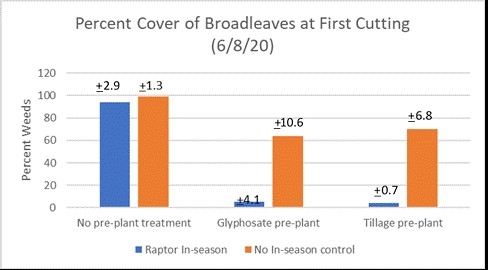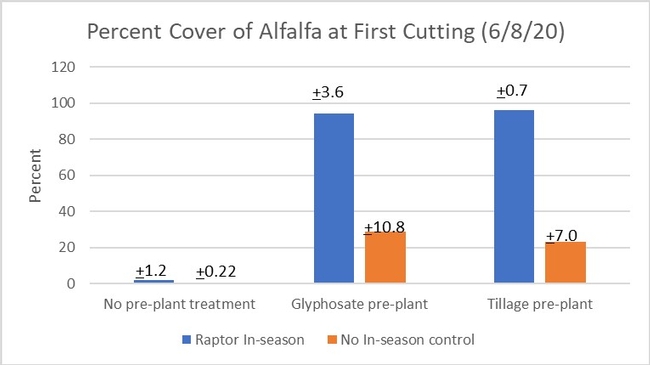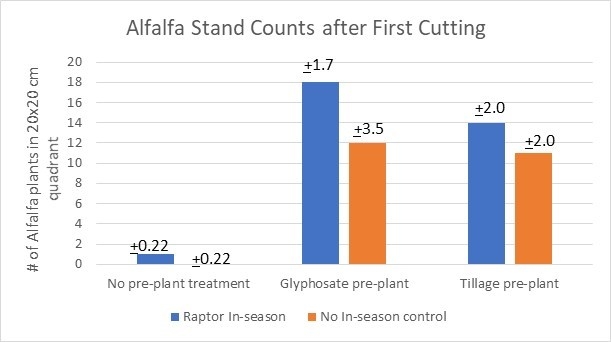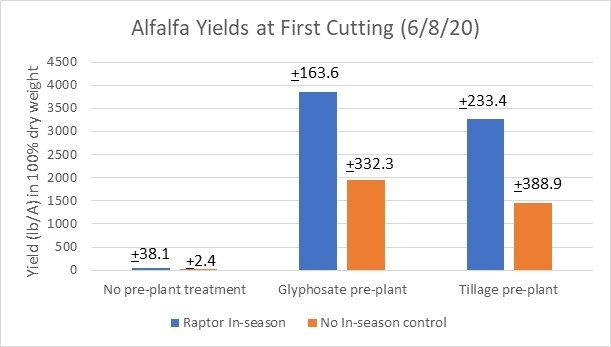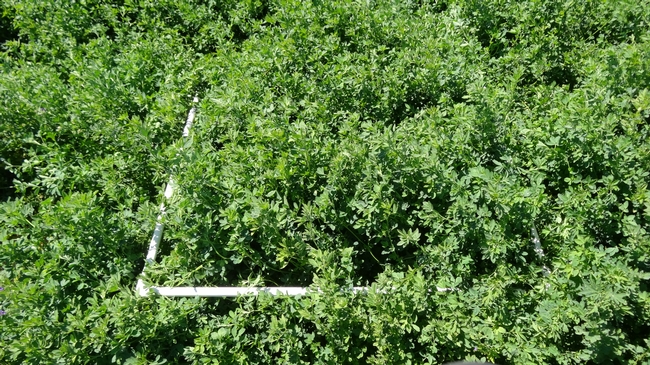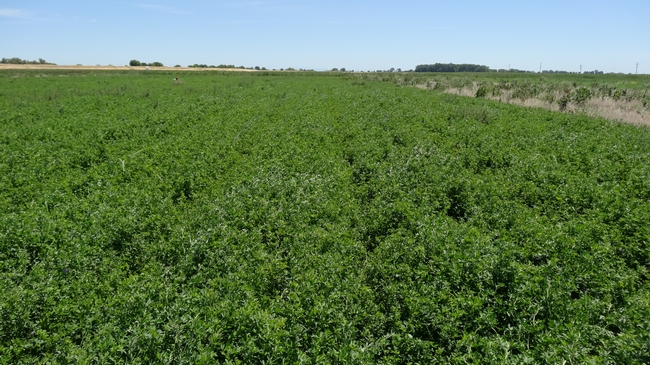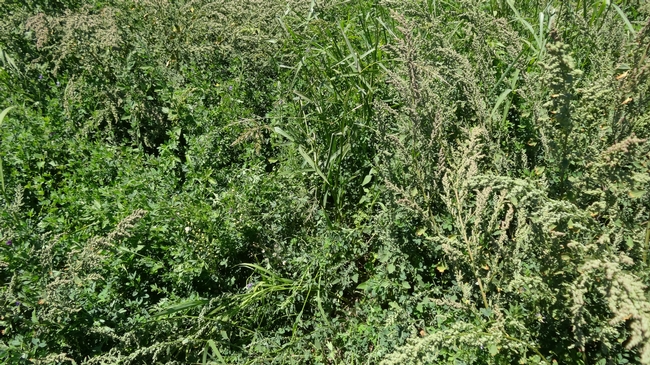Good stand establishment is important for alfalfa production and can impact crop productivity not only in year one, but for many years. Stand establishment weed control is one of the most important factors for both conventional and organic growers.
Weed competition during stand establishment may be irreversible because it impedes root growth, results in thinner alfalfa stands, and can lower forage quality due to poor stands.
This project evaluated the efficacy of pre-plant weed control in alfalfa using mechanical cultivation or Glyphosate spray with the goal of providing both organic and conventional growers with regionally relevant information about an integrated weed management tool for improved stand establishment.
METHODS
Experimental Design:
|
Table 1. Experimental treatments |
|||
|
Treatment number |
Pre-plant treatment |
In-season treatment |
Herbicide rate(s) |
|
1 |
None |
None |
None |
|
2 |
Tillage |
None |
None |
|
3 |
Glyphosate |
None |
3 pt/acre |
|
4 |
None |
Raptor |
6 fl oz/acre |
|
5 |
Tillage |
Raptor |
6 fl oz/acre |
|
6 |
Glyphosate |
Raptor |
3 pt/acre + 6 fl oz/acre |
Six treatments (Table 1) were replicated three times in the field. Main plots were a pre-plant treatment (either no pre-plant treatment, pre-plant tillage, or pre-plant Glyphosate). Additionally, half of the plots received later in-season treatment (Table 1); either no treatment or Raptor application in-season after the crop had emerged.
This was a spring planting in the Sacramento Valley of California (note: we generally recommend an early fall planting, but spring plantings are feasible if done early). Weeds were germinated with winter rains. On some plots, Pre-plant Glyphosate was sprayed on plots on 1/31/20 at a rate of 3 pints Glyphosate/acre. On other plots, mechanical cultivation (tillage treatments) were implemented on 2/11/20, once the soil was dry enough. This cultivation was very shallow, in the top few inches of the soil, to avoid bringing new weed seeds to the soil surface.
Alfalfa seed was flown on the field on 3/4/20 and the field was then ring-rolled to cover seed and get good seed-to-soil contact. Field was then irrigated for germination a week later. In-season weeds were controlled on some of the plots with a tank mix of Raptor (Imazamox Ammonium Salt) at 6 fl oz per acre and Buctril (Bromoxnil) on 4/25/20.
Data Collected: Baseline weed counts were taken on 1/29/20 from all plots before treatment implementation but after weed germination. Individual broadleaf weeds and grasses + sedges were counted in three random 20x20 cm quadrats per plot. Plants were counted on this date because weeds and alfalfa plants were small and percent cover would not have captured potential differences.
Weed counts were taken an additional three times between planting and first cutting from all plots. In season weed counts were taken as percent cover, in which the area of the quadrat was broken up in percent covered with broadleaves, grasses + sedges, bare soil, and alfalfa. On 4/9/20 and 5/14/20, weed counts were taken in three random 20x20 cm quadrats per plot and on 6/8/20 percent cover was observed in 3 random square meter quadrats per plot. The larger quadrat was used for percent cover on 6/8/20 because alfalfa and weeds were tall at this time and the meter by meter square allowed for more accurate representation of each plot.
Plots were hand harvested on 6/8/20 prior to first cutting by the grower, which occurred on 6/10/20. Two square meter areas of each plot, which were representative of the larger plot, were cut. Yield biomass was separated into weeds and alfalfa, dried, weighed separately, and then converted to a pounds dry matter/acre basis.
Finally, on 6/23/20 following first cutting, alfalfa stand counts were taken in all plots by counting the number of alfalfa plants in three 20x20 cm quadrats.
RESULTS
Baseline and early weed counts. The first weed counts (1/29/20) collected before treatment implementation showed the average count for grasses + sedges for all plots was zero at this count. For broadleaves, there were no significant differences by treatment but there were significantly more weeds in the side of the field with no in-season control compared to the side where Raptor was applied in-season. 4/9/20 Weed Counts. Grasses + sedges: There were not many grasses or sedges in the field. Broadleaves: There were significantly less broadleaves in the plots that had pre-plant weed control (Glyphosate or tillage). Alfalfa: Alfalfa plants were small at this counting date however, there were significant treatment differences with the pre-plant weed control treatments having more alfalfa than the control. 5/14/20 Weed Counts. (Data not shown). Grasses + sedges: There were not many grasses or sedges in the field. Broadleaves: There were significantly less broadleaves in the plots that had pre-plant weed control (Glyphosate or tillage) and in the plots that had Raptor applied in-season. Alfalfa: There was significantly more alfalfa in the plots that had pre-plant weed control (Glyphosate or tillage) and in the plots that had an in-season herbicide.
Figure 1. Broadleaf Weed Cover at first harvest as affected by pre-plant and in-season weed control.
Broadleaf Weeds Dominated at first cutting (6/8/20). There were significantly more broadleaf weeds in the plots that had no pre-plant weed control (Glyphosate or tillage) (Figure 1). Additionally, the plots that had Raptor applied in-season reduced broadleaf weeds down to negligible levels compared with no in-season treatment (Figure 1). There were not many grasses or sedges in the field, however, there were more grasses in the side of the field with no in-season herbicide application.
Figure 2. Effect of early weed management and follow-up in-season weed management on percent cover of alfalfa during establishment.
Figure 3. Alfalfa stand counts at first cutting showing significant effects of early pre-plant treatments, as well as the effect of in-season herbicide treatment.
Alfalfa Stand: There was significantly more alfalfa in the plots that had pre-plant weed control (Glyphosate or tillage) and in the plots that had an in-season herbicide (Figure 1). Weeds in the no-pre-plant treatment essentially killed many of the young seedlings due to weed competition. This is a key issue, since early growth and establishment of alfalfa seedlings sets the stage for vigorous growth over many years of production. This is the number of alfalfa plants in a 20cm2 quadrant after first cutting. There were significant differences in the alfalfa stand after first cutting. With regard to pre-plant treatments, both Glyphosate spray and tillage pre-plant significantly increased alfalfa stand compared to the plots with no pre-plant treatment.
Figure 4. First cut alfalfa yields as affected by early season and in-season weed management.
Alfalfa Yields Were Enhanced by early season and in-season weed management. Alfalfa yields were near zero for the plots where early control was not applied (Figure 4). Additionally yields were improved over 90% when an in-season weed control was applied (Figure 4). This yield data is only for the first cutting of the stand, not for the full first year of production. There were significant differences in alfalfa yield between pre-plant treatments and plots that had no pre-plant weed control (Figure 4). Both the Glyphosate and tillage pre-plant treatments increased yields. In addition, the Raptor spray significantly increased yields compared to plots without in-season control.
A combination of early weed control combined with in-season weed control was the most successful at controlling weeds and enhancing alfalfa yields.
Biomass was separated into alfalfa (above) and weeds after plots were hand-harvested. Then alfalfa and weeds were weighed separately by plot. There were significantly more weeds, by weight, in the side of the field that did not get the herbicide spray in season compared to the side that did get an herbicide spray. However, within one side of the field (Raptor or not), there were no significant differences by pre-plant treatment. In other words, even though there was more alfalfa in the plots with pre-plant weed control, there were also more weeds. The photos below, taken at harvest show how heavy the weed pressure was even in plots with Glyphosate and tillage pre-plant that did not have in-season herbicide application.
Figure 5: Glyphosate pre-plant plus in-season Raptor treatment showing excellent weed control
Figure 6. Broad View of Glyphosate pre-plant with in-season Raptor weed control
Figure 7. Early Glyphosate weed control with no in-season weed control. Late-germinating weeds were very competitive in this study.
When comparing plots with the same pre-plant treatments with or without in-season herbicide spray, plots that were tilled pre-plant did not have significantly different stand counts regardless of in-season herbicide treatment. However, within the plots that were sprayed with Glyphosate pre-plant, those that also were sprayed with Raptor in-season had significantly higher alfalfa stand counts than those that without in-season control.
PROJECT SUMMARY & CONCLUSIONS
The data shows that controlling weeds prior to planting, either with shallow tillage or an herbicide spray (Glyphosate) will reduce weed pressure, increase yields, and lead to a stronger alfalfa stand after first cutting. There were also differences between plots that got an in-season herbicide and those that did not. Yields were highest in plots that had both pre-plant weed control and an in-season herbicide. The plots with the highest stand counts after first cutting were also the plots that had both pre-plant and in-season weed control. However, the stand in the pre-plant treatment plots that did not have in-season herbicide application still had relatively high alfalfa stand counts after first cutting. This means that with early effective weed control, the alfalfa stand may be more robust for future cuttings, even if weed pressure was high initially. As shown in photos above, the alfalfa was robust in the understory of the canopy, even when broadleaf weeds were very large. By first cutting, many broad leaf weeds had gone to flower so likely would not return after first cutting. However, when included in the harvest these weeds reduce quality and price of the hay, and also contribute seed to the weed-seed population in the field.
Ideally, both pre-plant and in-season weed control would be implemented to get highest yields, quality, a vigorous stand, and ensure animal safety. However, growers (particularly organic) may be able to do a pre-plant tillage to control weeds and establish a good alfalfa stand, accept some yield reduction and additional weed pressure leading up to first cutting, and then have a strong alfalfa stand for subsequent cuttings.
Acknowledgments:
Many thanks to River Garden Farms, Knights Landing, CA, for collaborating on this project. Many thanks to the California Alfalfa & Forage Association for funding this project.
